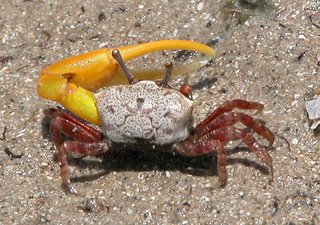Tiny blue-shelled fiddler crabs change their color to avoid being eaten by predatory birds, researchers have discovered.
Scientists have long been intrigued by the crabs' ability to change the color of their top shell from bright blue to a more subdued, muddy shade.

AP Photo/Australian National University
Brighter Color, Less to Fear
Certain species of fiddler crab, as seen in this undated handout photo, can alter their coloring from bright to dull if they sense predators are near, finds new research from Australian National University.
But exactly why the crabs change their color hasn't been clear.
"When you catch them, for instance, they go dull," said Jochen Zeil of the Australian National University in Canberra. Zeil's research appears in the Journal of Experimental Biology.
To find an answer, Zeil and his colleagues studied a particular species of fiddler crab, Uca vomeris, on the mud flats of Australia's northeast coast, south of Townsville.
"Some populations of these crabs are all very dull, but in other places they are very colorful," Zeil said. "We wanted to understand how this happens."
The scientists looked at variations between crabs from three different areas: one group was dull colored, another was colorful and a third group mixed.
They found differences in the numbers of crab-eating birds near the dull colored populations.
"In the places where the crabs were colorful, there were few birds," Zeil says. "But in the others there were more birds actively hunting crabs."
To confirm these findings, the scientists set up an experimental model to test whether the crabs changed their shell color in direct response to the threat of being eaten.
They found two very colorful crabs living close together and set up a kind of wooden screen between them.
One crab was left to go about its life as normal. But the other was subjected every couple of minutes to the attentions of a pretend bird. In reality, it was a small foam ball suspended on fishing wire.
Crabs have poor vision, so the approach of the black ball was enough to convince it a bird was coming, Zeil explained.
Within days, that crab had changed its color to the muddy shade, while the other remained colorful.
"We could observe that over a couple of days, the crabs did change their color when they are confronted with this dummy bird," the researcher said.
Scientists suspect the blue color of the crabs is normally used to help them identify others living close by, and avoid fights, Zeil said.
The next step in his research will be to see whether staying dull all the time has any effect on neighborly relations.
Reference:discovery
No comments:
Post a Comment